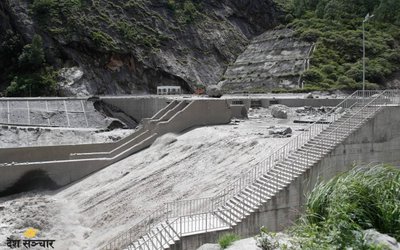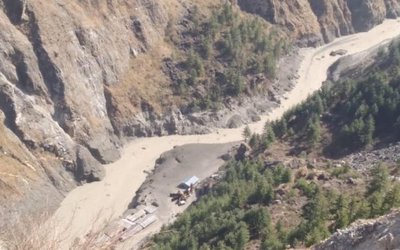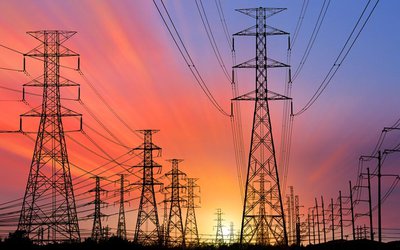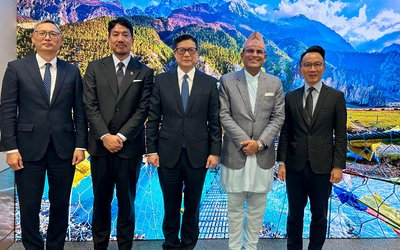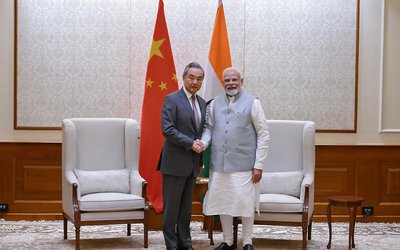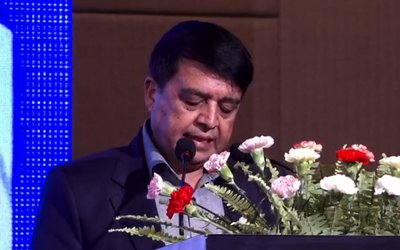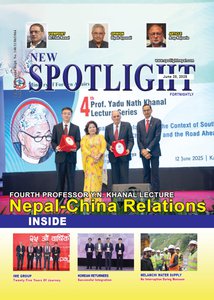
Before the budget in Jestha, electric cars had to pay only 10% excise duty and 13% VAT, minimum customs duty and were exempted from annual road tax of Rs 30,000. This led to a dramatic increase in the sale of electric cars in Nepal as they were more competitive than fossil fuel cars, which are taxed at around 260%.
Nepal is known to have huge potential for hydroelectricity due to the numerous rivers flowing through the Himalayan mountains.Charging electric vehicles with clean energy is economically viable in the country.This seems to be a new campaign to really bring about change in the efforts to address the climate crisis. According to data released by the Customs Department, the import of diesel, petrol and electric vehicles increased in the fiscal year 2081/82, along with an increase in revenue.As of fiscal year 2081/82, 31,386 electric vehicles (EVs) have been imported into Nepal.
In the fiscal year 2076/77, one vehicle in the 100 to 150 kW range was imported, and from the following year, imports have started at a higher rate. If we take a quick look at the data of the Customs Department, 249 electric vehicles have entered Nepal in the fiscal year 2077/78, 1,807 in the fiscal year 2078/79, 4,500 in the fiscal year 2079/80, 11,701 in the fiscal year 2080/81, and 13,578 in the last fiscal year.
In the fiscal year 2080/81, there was a qualitative increase in the import of electric vehicles compared to previous years.There were about three times more imports in the fiscal year 2080/81 than in the fiscal year 2079/80.
In the fiscal year 2080/81, 4,571 electric vehicles up to 50 kW, 6,885 from 51 kW to 100 kW, 217 from 101 to 200 kW, 27 from 201 kW to 300 kW and one above 300 kW were imported.
Last fiscal year, Rs 11.81 billion revenue was collected from the import of 7,431 electric cars, jeeps and vans above 51 kW and 100 kW.
Advantages:
Low fuel costs in EVs.In most cases, much less.Less maintenance.And all that time spent doing oil changes, radiator flushes, etc. is taken care of!Fast, clean, quiet.
These are the more subtle things to remember over time.No oil spills on the driveway.No clunky transmission moving the car forward.Virtually no noise, and no smell.
It's noticeable at stoplights after a few months with the windows down.All the stench from other cars' exhausts!
Disadvantages:
The inability to charge at home makes EV ownership a big challenge.It can be done, but it's likely to be less convenient.There may be a lack of charging infrastructure in the place where you drive.
Nepal is an import market because the demand for electric vehicles is increasing day by day here.The recent energy crisis has increased people's interest in electric vehicles and some have started keeping electric two-wheelers as an alternative vehicle.This shows that the potential for electric vehicles here is bright. The government should support the electric vehicle industry by providing various subsidies like in other countries.Similarly, the government should also ease the customs duty on electric vehicles.
EVs need to move fast.
The rare earth magnet crisis is here and now and must be resolved immediately.The government should not make decisions based on sentiment, but on the nature and urgency of the problem.
The auto sector is heading towards a serious manufacturing crisis, and the government should not treat it as a problem of the future.The biggest challenge with vehicles in general in Nepal is the high import duties on vehicles and vehicle parts, which also apply to bicycles.
Looking ahead, over the past few years, the EV sector in the country has become a major focus of government initiatives to promote sustainable transport.Although the EV market is relatively small, it is experiencing steady growth.
The number of electric vehicles on the road – which includes electric cars, two-wheelers and three-wheelers such as e-rickshaws – is increasing, indicating a gradual shift towards electric mobility.
The most obvious benefit is their lower operating costs compared to conventional vehicles.Furthermore, electric vehicles are generally cheaper than petrol or diesel, resulting in significant savings on fuel costs.Despite growing awareness of the environmental benefits of EVs, many potential buyers remain concerned about the perceived risks and the adequacy of charging infrastructure. Subsidies and reduced taxes have made EVs more affordable in the past, and the related exhibition has also seen an increase in emphasis and attraction. This is in line with global trends towards cleaner transport solutions aimed at reducing carbon footprint and improving air quality. The expansion of charging infrastructure is another positive development.
The current infrastructure is inadequate for long-distance travel, leading to the misconception that EVs are impractical for users outside urban centers, which is also true. The only way to save is to make it equally affordable for everyone.So how much investment depends on the scale and complexity of the product.
Cars, in themselves, are complex and expensive, the market for them in Nepal is relatively small and already flooded with offerings from Indian, Chinese, European and American companies whose pockets are much deeper than yours, and there are much larger global markets to amortize the development costs.
So, if you look at the local market, fuel constraints are a weakness for petrol vehicles, while rolling blackouts are a weakness for larger electric vehicles.
But altitude means solar power works particularly well, as long as you clean the panels from time to time, so the sweet spot is EVs that are light enough that they can be recharged from solar power...
This avoids both grid power constraints and fuel constraints. Nepal’s electric leap:
How this mountainous nation is leading the way in global EV adoption Nepal, known worldwide for its Everest and trekking tourism, is quietly setting a remarkable benchmark in electric vehicle adoption. Nearly 70% of new passenger vehicles sold in this mountainous nation of 30 million people are now electric, overturning the perception that EV transitions are limited to wealthy countries with extensive infrastructure.
Nepal’s rapid shift towards EVs is largely driven by strategic government policies.Historically high import duties on petrol vehicles, up to 300%, contrast sharply with significantly lower duties of 25-90% for EVs, which often make electric vehicles more affordable than conventional cars. Recent increases in customs and excise duties are creating market uncertainty.These rising tax rates could hinder market growth by making EVs less affordable and discouraging investment in advanced models.
In this context, with strategic planning and continued government support, the ability to lead in sustainable transportation and overcome the barriers that currently hinder the widespread adoption of electric vehicles is indispensable. Safety concerns and public perception issues have further complicated the adoption of electric vehicles. Concerns about battery safety, including the risk of explosion, contribute to consumer hesitation. Despite growing awareness of the environmental benefits of EVs, many potential buyers are concerned about the perceived risks and adequacy of charging infrastructure. Supplementary financial incentives, accessible bank financing, and reduced annual registration fees further strengthen EV attractiveness.
Investment in grid reliability, load shedding elimination, and extensive charging infrastructure deployment, with nearly 400 stations and plans to double this within a year, will further facilitate widespread EV adoption.
Nepal’s experience proves that effective EVs do not require huge capital outlays, just strategic policies, smart infrastructure investments, and leveraging local renewable resources. In Nepal, another significant disadvantage is the issue of unreliable electricity supply.
Frequent power outages and the inability of transformers to handle high voltages pose risks to the viability of EVs.If the power supply remains unstable, it could undermine the reliability of charging infrastructure and further complicate the widespread adoption of electric vehicles.
To ensure the reliability of charging infrastructure, it is necessary to improve the power supply system.Upgrading the power grid and introducing advanced transformers will help address the challenges of unstable electricity and increase the viability of EVs across Nepal.
While the electric vehicle sector in Nepal is making significant progress, it faces significant challenges on the path to widespread adoption.The attractiveness of the sector is evident in its economic and environmental benefits, which are strengthened by advances in technology and infrastructure expansion.
This is a compelling issue for global policymakers, demonstrating that thoughtful planning can accelerate clean transportation even in economically modest contexts. Overall, addressing limited charging infrastructure, rising tax burdens, and safety concerns is imperative and even crucial to ensuring the successful growth of EVs. With strategic planning and consistent government policy and support, Nepal has the potential to lead in sustainable transportation and overcome the barriers that currently hinder the widespread use of electric vehicles.
- Nepal's Participation In The Landlocked Developing Countries (LLDC) Conference
- Aug 04, 2025
- Susan's “U-Turn” From Atheism To Spirituality And Superstition: Some Considerations
- Jun 29, 2025
- Former Ambassador To People’s Republic Of China Acharya's 'Diplomatic Diary': A Collection Of "Autobiography " Including Diplomacy
- Jun 17, 2025
- Banker And Businessman Being The Same Person: How Practical, How Impractical
- Jun 01, 2025
- 2082/83 Policy And Program: Presentation New, Short But Not Exciting
- May 07, 2025

